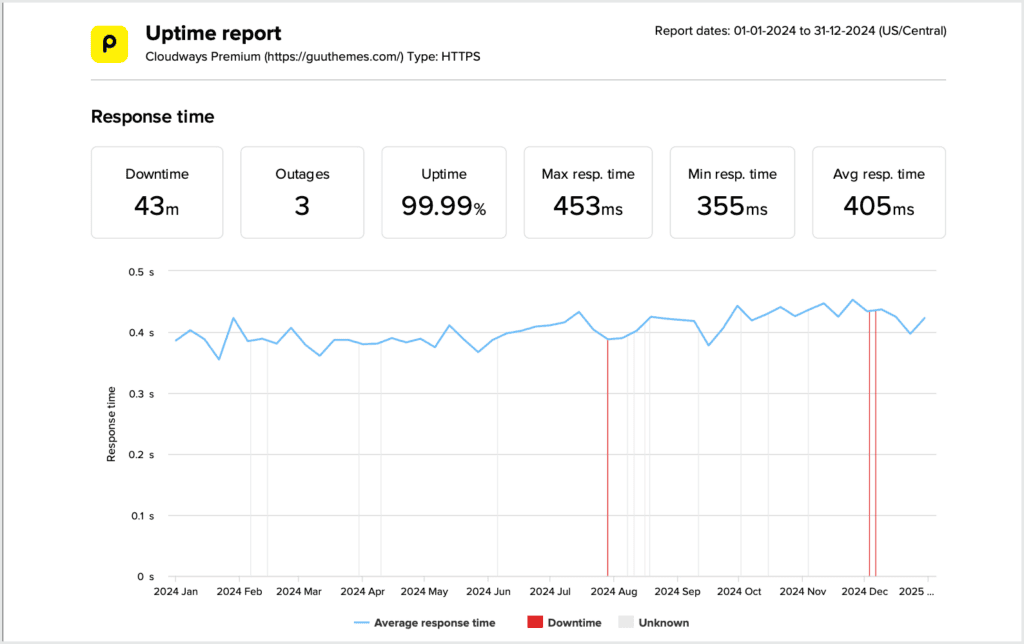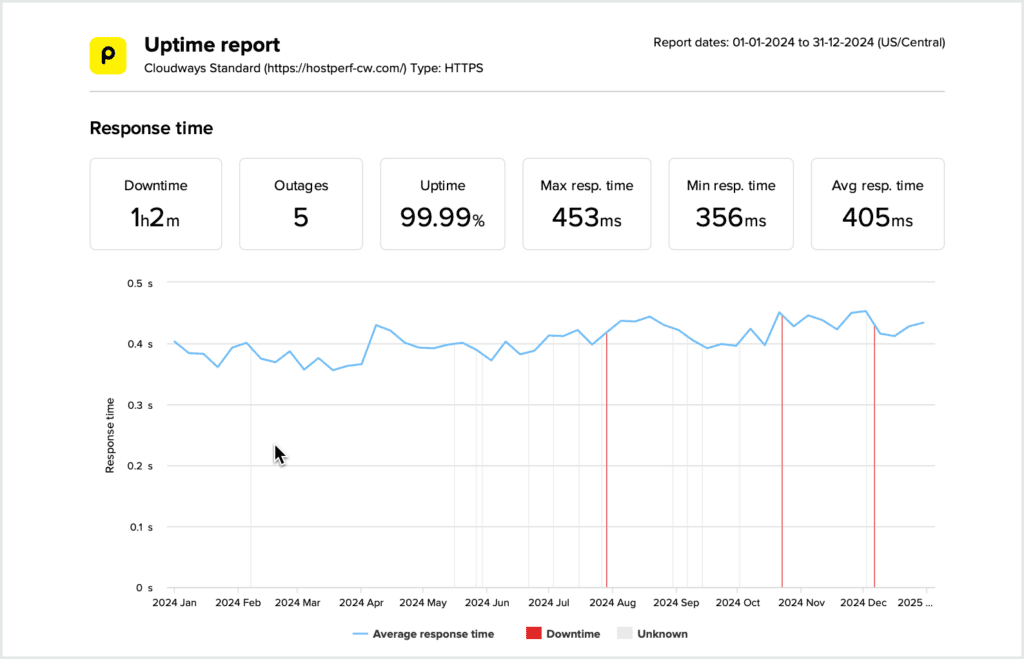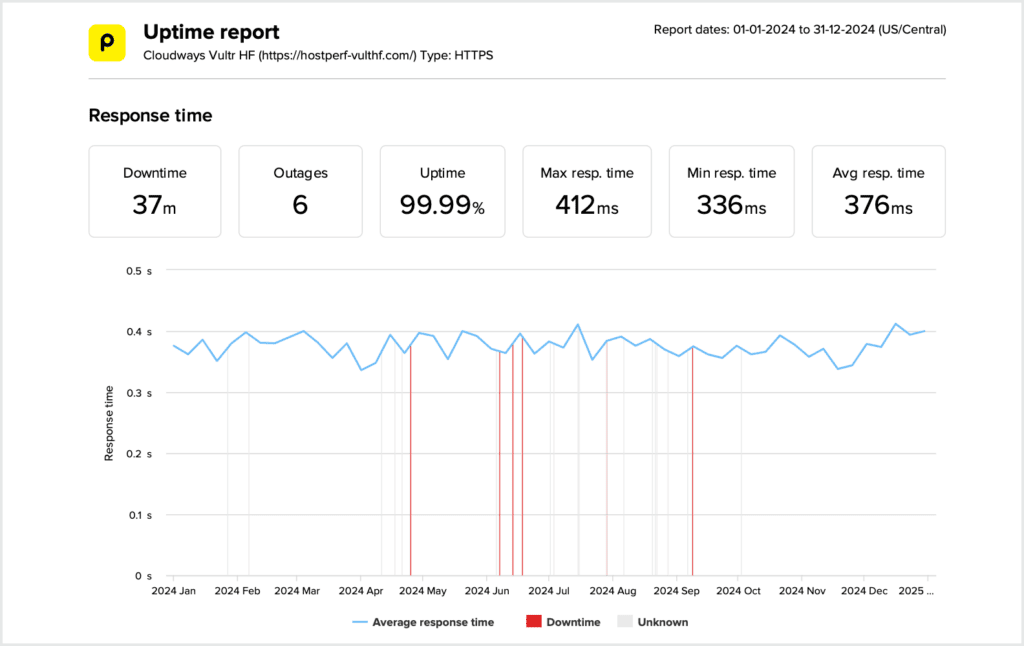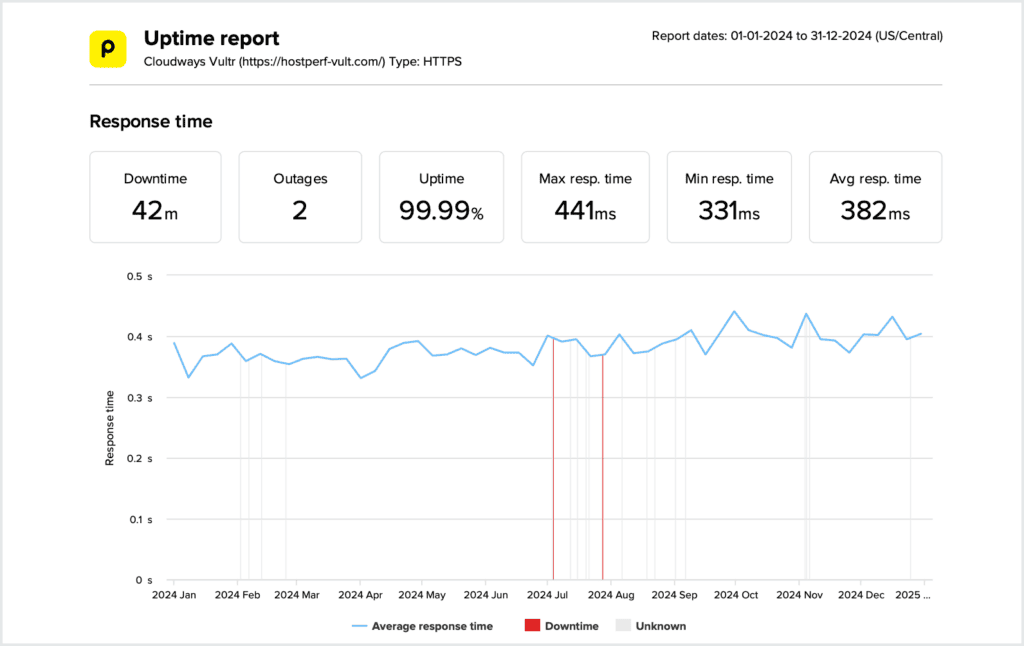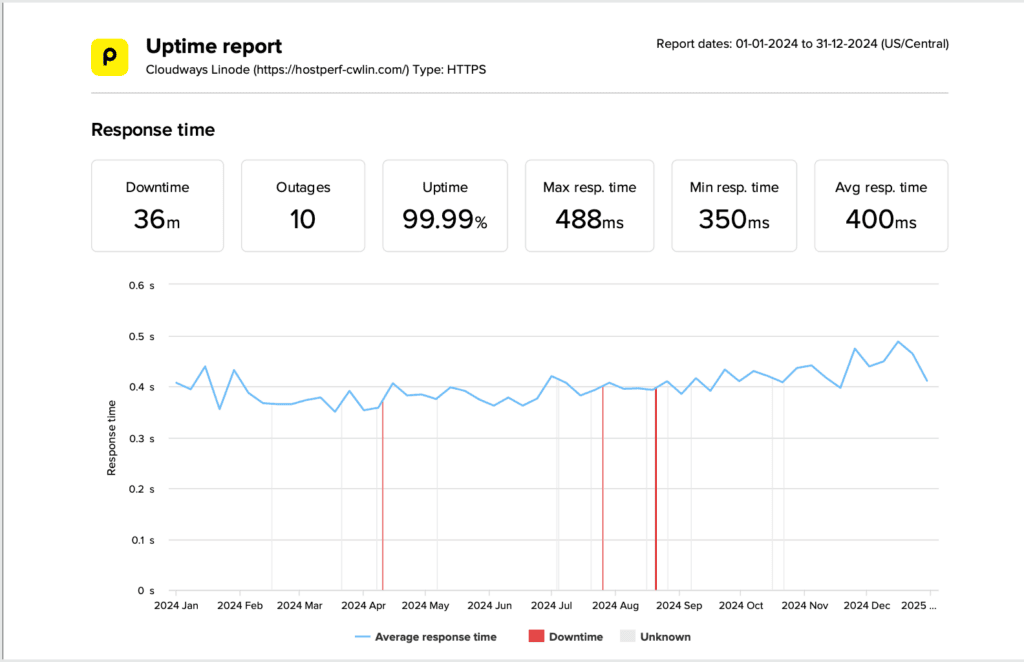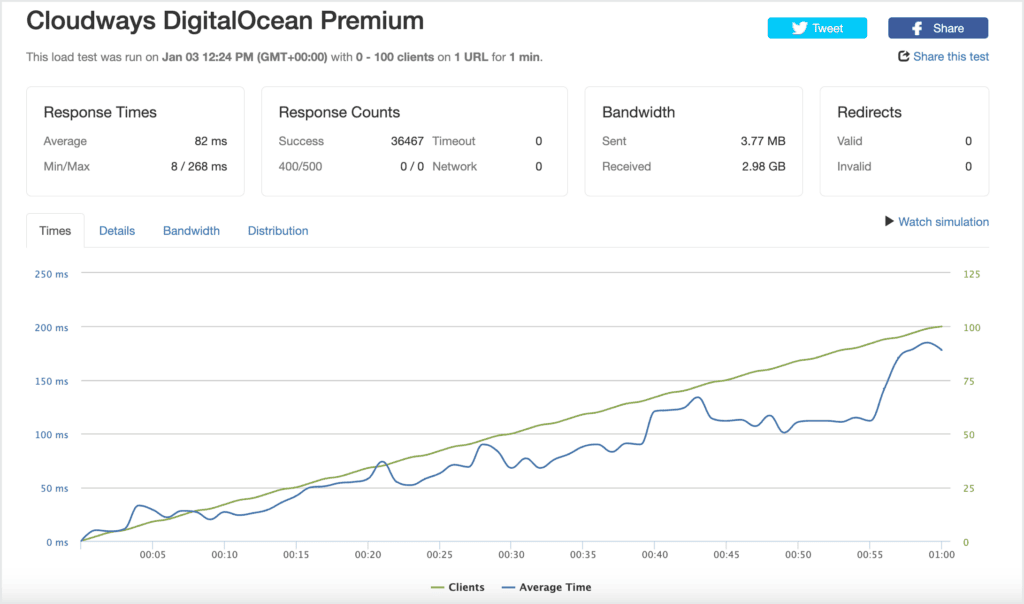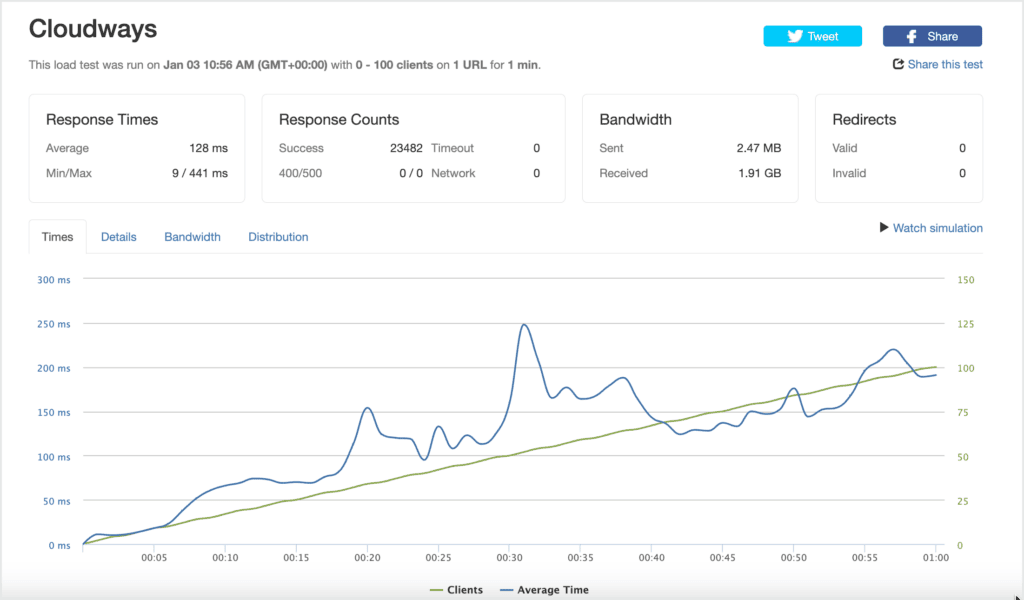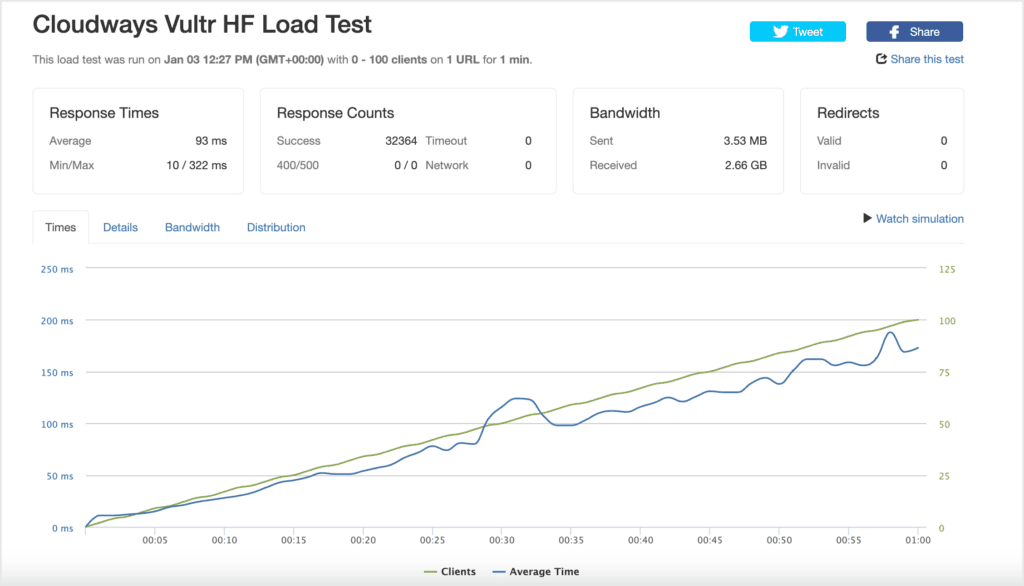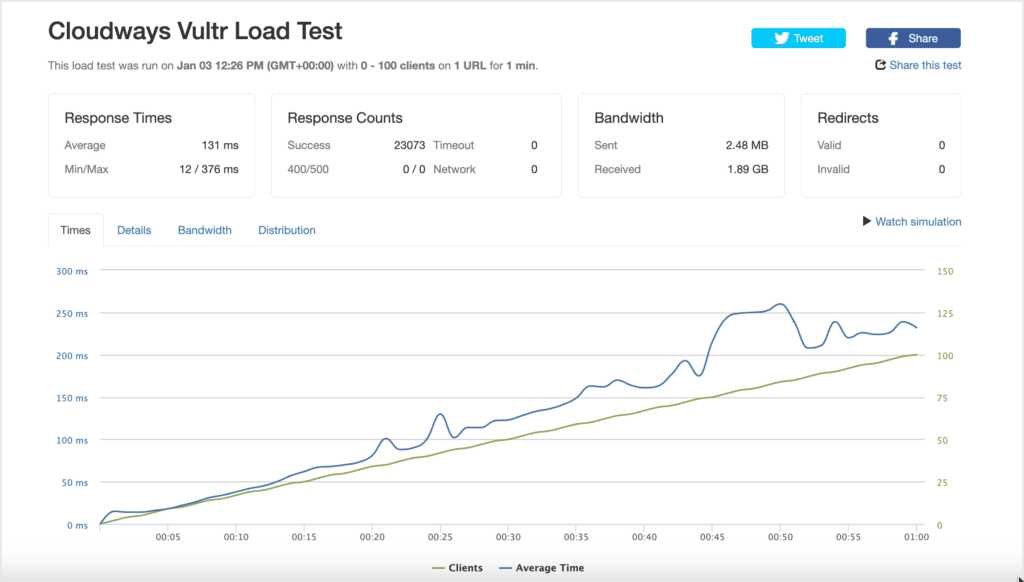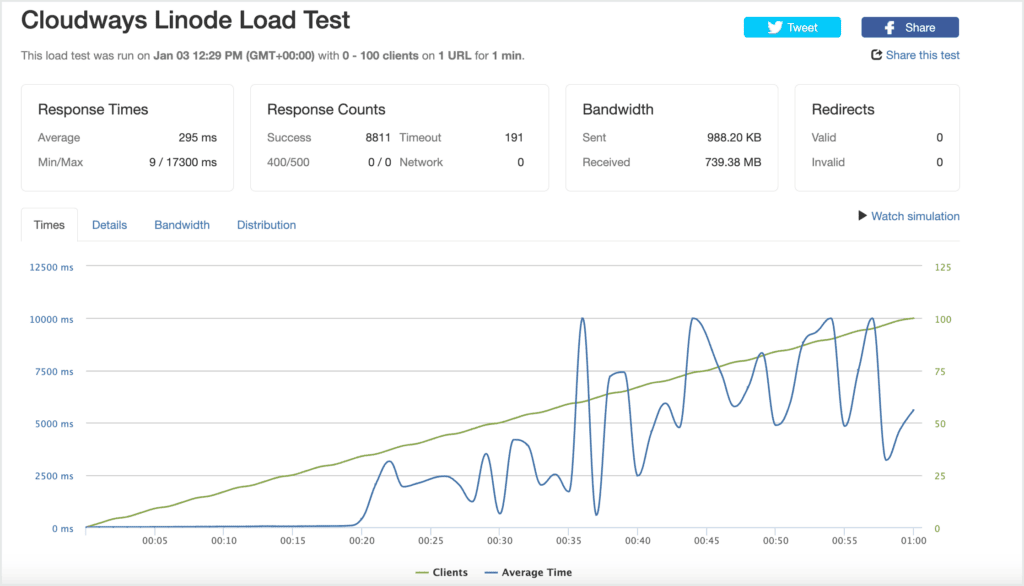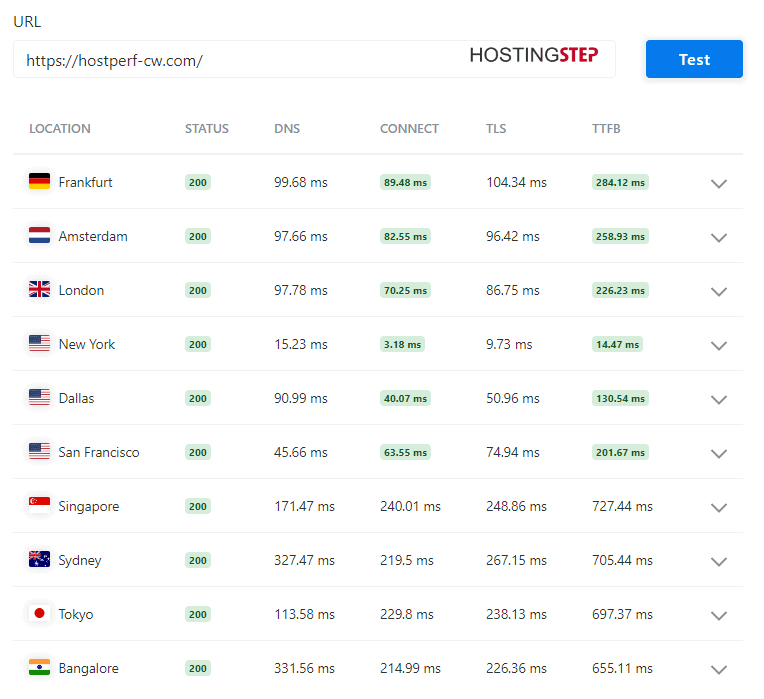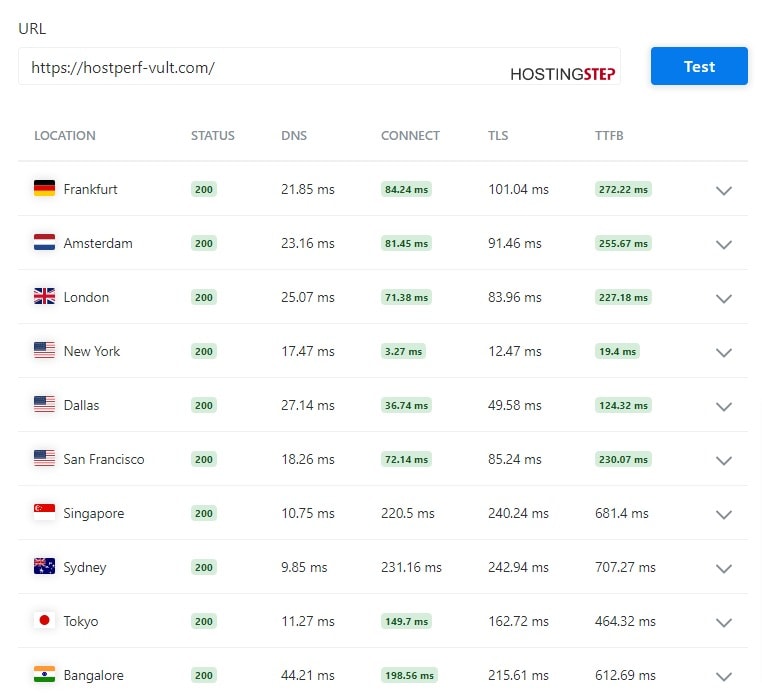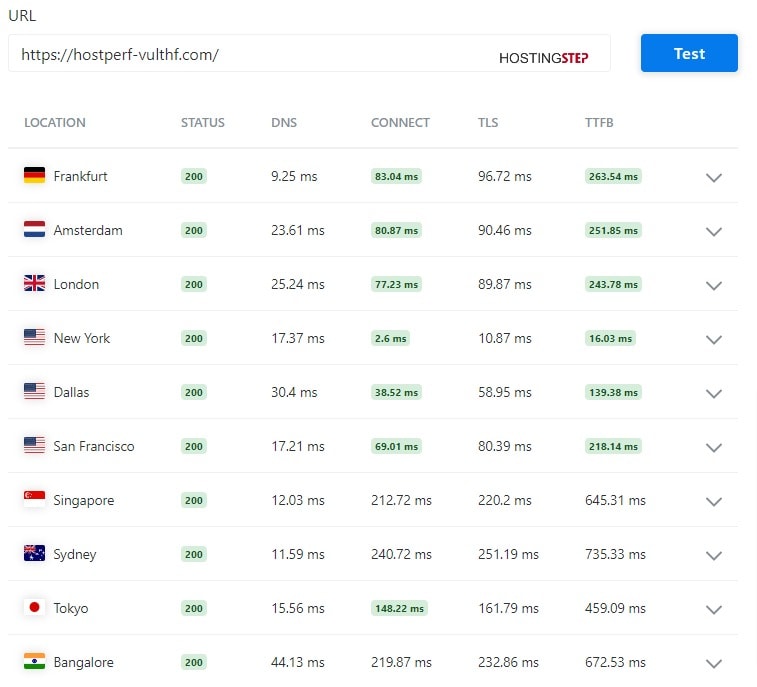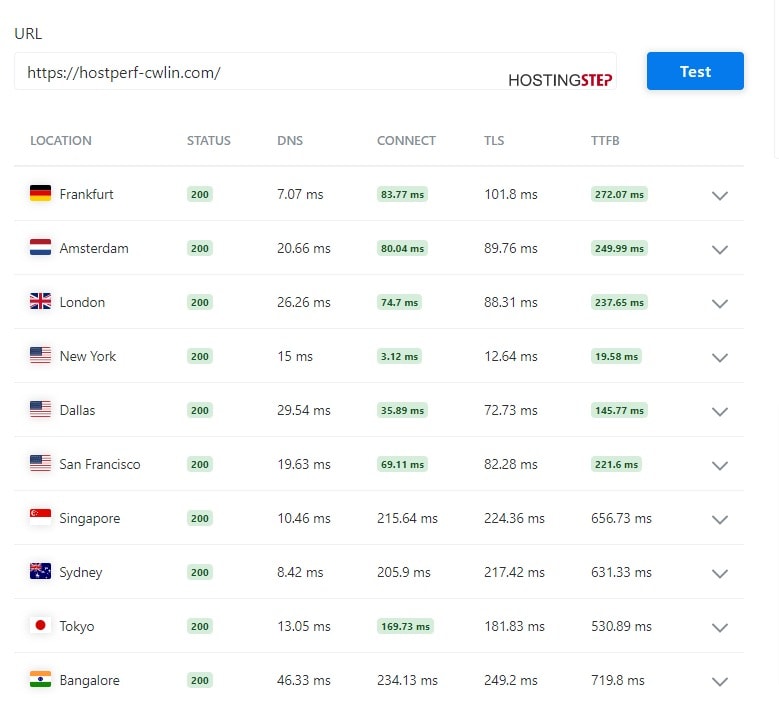Cloudways DigitalOcean Vs Vultr Vs Linode: 12 Months Performance Data
Based on our 12-month comprehensive testing (January-December 2024), we compared Cloudways’ five cloud providers across four critical performance metrics. Here’s what we discovered.
- Identical WordPress sites with Twenty Twenty-Four theme, Contact Form 7, Rank Math SEO, Breeze caching, and Akismet
- 24/7 monitoring for 365 days (January 1 – December 31, 2024)
- Server response time (TTFB) measured every 60 seconds from 22 USA locations
- Load testing with 100 constant visitors
- Global TTFB measured from 10 international locations
| Cloud Provider | TTFB |
|---|---|
| DigitalOcean Premium | 405ms |
| DigitalOcean Standard | 405ms |
| Vultr HF | 376ms |
| Vultr Standard | 382ms |
| Linode | 400ms |
Note: All providers showed similar TTFB due to Cloudways’ standardized optimization.
| Cloud Provider | Uptime | Total Downtime | Outages |
|---|---|---|---|
| DigitalOcean Premium | 99.99% | 43 minutes | 3 |
| DigitalOcean Standard | 99.99% | 1 hour 2 mins | 5 |
| Vultr HF | 99.99% | 37 minutes | 6 |
| Vultr Standard | 99.99% | 42 minutes | 2 |
| Linode | 99.99% | 36 minutes | 10 |
| Cloud Provider | Response Time |
|---|---|
| DigitalOcean Premium | 82ms |
| DigitalOcean Standard | 128ms |
| Vultr HF | 93ms |
| Vultr Standard | 131ms |
| Linode | 295ms |
The load test clearly shows DigitalOcean Premium and Vultr HF significantly outperform other options.
| Cloud Provider | Global TTFB |
|---|---|
| DigitalOcean Premium | 365.07ms |
| DigitalOcean Standard | 369.81ms |
| Vultr Standard | 359.45ms |
| Vultr HF | 364.49ms |
| Linode | 368.54ms |
All providers performed within 10ms of each other for global response times.
In this post, I’m comparing the performance of Cloudways DigitalOcean, Vultr, and Linode based on not one but four crucial tests.
I do methodology based web hosting benchmarks and as a par of it, I bought the Cloudways starter plan from all their popular cloud providers like DigitalOcean Premium/standard, Linode, and Vultr Standard/HF. I deployed identical sites on all the providers and started monitoring the performance 24/7, 365 days a year.
Now, using our proprietary data tracked from January 1, 2024, to December 31, 2024, I’m listing out the pros and cons of each cloud provider by comparing its performance.
The test sites come with the following setup:
- Twenty Twenty-Four WordPress Theme
- Contact form 7
- Rank Math SEO
- Breeze caching plugin.
- Akismet
The tests are put into four different testing benchmarks. They are:
- Server Response Time (TTFB): The test site is measured every 60 seconds once from 22 USA locations through the Pingdom synthetic monitoring tool to calculate the average server response time (TTFB).
- Uptime: We use the same Pingdom data above to measure the uptime.
- Load Testing: A 500 constant client load is sent to test the load handling.
- Global TTFB: The global TTFB is calculated from 10 different locations.
Cloudways DigitalOcean Vs Vultr Vs Linode: Performance tests
Test 1 – Server Response Time (TTFB)
The server response time(TTFB) is the crucial test for evaluating any hosting provider. To calculate the average TTFB, all our test sites are pinged 60 seconds once from 22 North American regions.
Based on 12 months of performance data (January 1, 2024, to December 31, 2024), the average TTFB is very similar to each other. While both Cloudways DigitalOcean Premium and Standard clocked 405ms, Linode got 400ms, the Vultr HF got 376ms and the regular Vultr with 382ms.
- Cloudways DigitalOcean Premium: 405ms
- Cloudways DigitalOcean Standard: 405ms
- Cloudways Vultr HF: 376ms
- Cloudways Vultr: 382ms
- Cloudways Linode: 400ms
DigitalOcean Premium DigitalOcean Standard Vultr HF Vultr Linode
The identical scores are due to the Cloudways speed-optimized WordPress installations. So, it doesn’t matter which cloud provider you choose; you will get a similar speed experience.
Let’s move to the next uptime test to see if any difference prevails.
Test 2 – Uptime
Like the TTFB test, the uptime is measured by pinging the test sites every 60 seconds once from 22 North American regions. The 12-month average uptime of all the sites is 99.99% (Refer to the TTFB Pingdom screenshot for uptime data.)
| Cloudways Plans | Uptime | Total Downtimes | Outages |
|---|---|---|---|
| DigitalOcean Premium | 99.99% | 43 minutes | 3 |
| DigitalOcean Standard | 99.99% | 1 hour 2 mins | 5 |
| Vultr HF | 99.99% | 37 minutes | 6 |
| Vultr | 99.99% | 42 minutes | 2 |
| Linode | 99.99% | 36 minutes | 10 |
In simple numbers, it looks like all the cloud providers offer the same uptime percentage. But if you look at the absolute numbers, it differs to some extent.
It’s hard to believe sites hosted on different data centers of different cloud providers offer a similar uptime score.
My Verdict: It’s good to see that Cloudways offers very similar TTFB and uptime scores across all its cloud providers. So, if someone says Vultr HF is fastest or DigitalOcean Premium is superior, it’s probably their own thoughts and our data proves them wrong, in terms of plain TTFB speed and uptime.
Let’s move to the next load testing benchmarks.
Test 3 – Load Testing
Load testing is another critical test to see how well the servers can handle bulk traffic.
In this test, I’ll distribute 100 constant client loads to the site for a minute to measure the average response time. The lower response time means the server is faster.
- Cloudways DigitalOcean Premium: 82ms
- Cloudways DigitalOcean Standard: 128ms
- Cloudways Vultr HF: 93ms
- Cloudways Vultr: 131ms
- Cloudways Linode: 295ms.
The results are clear now. Cloudways DigitalOcean Premium and Vultr HF are equally fastest at handling load with 82ms and 93ms, respectively. While the lower versions somewhat have similar scores of 128ms and 131ms, Linode has become the slowest among all, with 295ms.
So, if you choose a plan specifically to handle traffic spikes, Cloudways DigitalOcean Premium and Vultr HF are recommended.
Test 4 – Global TTFB
Our test 1 TTFB is measured only from 22 North American regions, and this global test is conducted from different global locations. If your site gets global traffic, these results are useful for assessing which server is best for you.
The Overall global TTFB of each host is Digital Ocean Standard (369.81 ms), Premium (365.07 ms), Vultr (359.45 ms), Vultr HF (364.49 ms), and Linode (368.54 ms). There is just a 10 ms difference between each host.
| Data | DO Standard | DO Premium | Vultr | Vultr HF | Linode |
|---|---|---|---|---|---|
| New York | 15.88 | 19.18 | 19.4 | 16.03 | 19.58 |
| Dallas | 132.76 | 138.56 | 124.32 | 139.38 | 145.77 |
| San Francisco | 204.62 | 221.16 | 230.07 | 218.14 | 221.6 |
| London | 219.58 | 242.2 | 227.18 | 243.78 | 237.65 |
| Amsterdam | 252.69 | 255.5 | 255.67 | 251.85 | 249.99 |
| Frankfurt | 284.72 | 280.93 | 272.22 | 263.54 | 272.07 |
| Bangalore | 676.88 | 635.57 | 612.69 | 672.53 | 719.8 |
| Singapore | 743.68 | 683.53 | 681.4 | 645.31 | 656.73 |
| Tokyo | 525.6 | 526.36 | 464.32 | 459.09 | 530.89 |
| Sydney | 641.72 | 647.68 | 707.27 | 735.33 | 631.33 |
| Average (in ms) | 369.81 ms | 365.07ms | 359.45 ms | 364.49 ms | 368.54 ms |
Which is the best Cloud Provider at Cloudways?
Based on the data, I recommend both DigitalOcean Premium and Vultr HF as the best options to get started. Since DigitalOcean owns Cloudways, their plans are much more affordable compared to Vultr’s Plans. So, if you like Vultr personally, go for it.
If you don’t have any particular preferences, then Cloudways DigitalOcean Premium is the best and most valuable choice for getting started. Check Cloudways Coupon Code for 30% off for up to 3 months. Sometimes up to 4 months, across all Cloudways providers.
Changelog:
March 25, 2025: Removed Core Web Vitals test as it doesn’t bring much value to users. We updated the post with the new TTFB, uptime, and load test for 2025.
September 10, 2024: Improved content accuracy.
April 10, 2024: We tested the latest Cloudways Autonomous plan. They offer greater load handling than any other cloud provider tested above. Check out the reviews.
April 10, 2024: The old 5-month data from August 31, 2022, to January 31, 2023, is replaced with the new 1-year data from January 1, 2023, to December 31, 2023.
April 10, 2024: Removed 1000 constant client load, as it offers similar results to 500 constant client load.
April 10, 2024: New load testing is done on this date to get a refreshed load testing data. The results are updated on the page on the same day.

